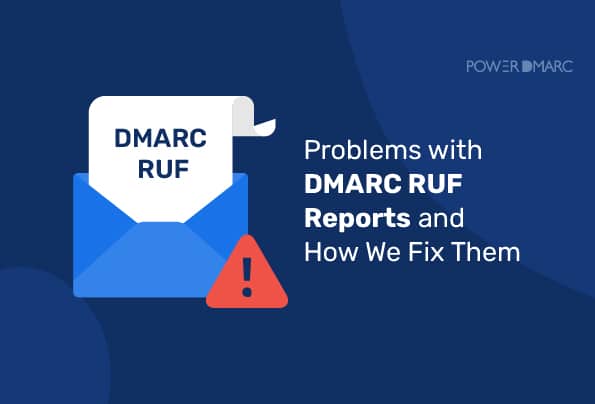DMARC forensic reports, more commonly called the RUF or Failure reports, contain details about emails that failed SPF, DKIM, and DMARC authentication checks. Senders can receive diagnostic results on the reasons for these failures and discover ways to fix the issues promptly.
RUF reports are the backbone of email security and deliverability processes, however, they have some problems and limitations linked to it. This guide discusses them and explains how PowerDMARC supports resolving them with minimal effort.
Significance of DMARC in Securing Email Infrastructures
DMARC is an email authentication protocol that works with SPF and/or DKIM results as the base source for operations. It empowers domain owners to take action against unauthenticated emails, offering a significant advantage to businesses across the board. When executed effectively, DMARC enhances email deliverability. It prevents spammers from tarnishing a domain’s credibility by dispatching emails falsely claiming to originate from that domain.
Using a DMARC record, domain owners instruct recipients’ mail servers on how to treat emails failing SPF and/or DKIM checks.
You can use one of the following DMARC policies in your record-
The None Policy (p=none)
It’s a relaxed DMARC policy and is usually set in the initial deployment phase so that domain owners can monitor how their email system is being used. It offers no protection from phishing, spoofing, or spamming, as no action is taken against emails failing authentication checks.
The Quarantine Policy (p=quarantine)
It’s a relatively stricter policy, prompting recipients’ mail servers to place unauthorized emails in the quarantine folder.
The Reject Policy (p=reject)
It’s the strictest policy according to which illegitimate messages are rejected and discarded by MTAs for the best protection against email-based cyberattacks.
Read here: Why Do Companies Need to Take DMARC Adoption Seriously?
How Does a RUF Report Work?
RUF has a header, attachments, URLs, time of receiving the message, subject line, and authentication results. The process of generating and sending it progresses as follows-
- Emails with DMARC records and ‘ruf’ tags are sent, indicating the sender’s email for reporting authentication failures.
- If DMARC fails (occurrence of SPF or DKIM misalignment), then ISPs generate forensic reports, containing message-level data, IP addresses, sources, and sometimes email bodies.
- DMARC rarely sends the email body unless the client uses a PGP key in the DMARC analyzer. A user-uploaded public key results in encrypted messages.
- Users can decrypt the reports locally using PGP decryption tools and your passphrase
The Role of RUF Reports in DMARC Management
Email infrastructures become more complicated with the involvement of third-party vendors that are outsourced for tasks involving the transmission of emails on your behalf. The existence and utility of RUF reports make DMARC management a little easier, as authors get notified when messages fail to reach the desired destinations.
You can leverage these well-diagnosed reports to highlight suspicious and disloyal entities that could be possibly stemming out of internal sources only. Its ability to empower you to make swift remediation mitigates ramifications, which can otherwise expose your clients and prospects to the odds of getting scammed.
Common Problems with DMARC RUF Reports
1. Sensitive Information Exposure
RUF reports can contain sensitive email content, headers, and potentially personally identifiable information (PII) if the email messages are included in the reports. If these reports are intercepted or leaked, they could expose confidential information.
2. Data Breach Risk
Since RUF reports contain detailed information about email messages, a mishandling of these reports could lead to a data breach, especially if the reports are stored insecurely or shared with unauthorized individuals.
3. Privacy Concerns
The detailed information in RUF reports could violate the privacy of individuals whose emails are included. Organizations need to ensure that the information in these reports is properly anonymized and protected.
4. Abuse and Phishing
Attackers could potentially abuse RUF reports to learn about the success or failure of their phishing campaigns. They could use this information to fine-tune their attacks and avoid detection.
Mitigating DMARC RUF Security Problems with PowerDMARC’s Encrypted Human-readable Forensic Reports
Key Benefits of PowerDMARC’s Solution:
1. Enhanced Security
By leveraging PGP encryption, PowerDMARC ensures that Forensic Reports remain confidential and protected against interception or unauthorized access during transmission. This encryption mechanism adds an extra layer of security, preventing any unauthorized parties from gaining insights into your email authentication activity.
2. Privacy Protection
PowerDMARC’s solution emphasizes the importance of privacy. Encrypted reports mean that even if they were to fall into the wrong hands, the information contained within would remain unreadable without the decryption key.
3. Human-Readable Format
Traditional RUF reports can be complex and require technical expertise to interpret. PowerDMARC’s reports are presented on the DMARC report analyzer dashboard in a human-readable format, making it easier for both technical and non-technical people to understand and take actionable insights from the data.
4. Granular Access Control
With PGP encryption, you can control who has access to the decryption key, limiting the audience to authorized personnel only. This feature reduces the risk of accidental exposure.
5. Regulatory Compliance
PowerDMARC’s solution aligns with data protection regulations and industry standards, ensuring that your organization remains compliant while benefiting from actionable insights.
Implementing PowerDMARC’s Solution
Step1: Setup
Begin by setting up DMARC and PowerDMARC for your domain. PowerDMARC acts as an intermediary to collect, aggregate, and process DMARC reports.
Step 2: Enable PGP Encryption
Configure your PowerDMARC account to enable PGP encryption for Forensic Reports.
Step 3: Key Management
Generate and manage PGP keys for encryption and decryption. Store the decryption key securely to maintain control over who can access the reports.
Step 4: Access and Analysis
Authorized users can then decrypt and access the human-readable Forensic Reports using a free online decryption tool (e.g https://8gwifi.org/pgpencdec.jsp), gaining valuable insights into email authentication activity.
Conclusion
As email threats continue to evolve, the need for robust email authentication and security solutions becomes increasingly evident. PowerDMARC’s PGP encrypted human-readable Forensic Reports address the security vulnerabilities associated with traditional DMARC RUF reports, offering enhanced protection, privacy, and actionable insights.
By adopting this innovative solution, organizations can strengthen their email security posture while maintaining compliance and safeguarding sensitive information from potential breaches.
Contact us today to strengthen your email infrastructure.
- DMARC MSP Case Study: CloudTech24 Simplies Domain Security Management for Clients with PowerDMARC - October 24, 2024
- The Security Risks Of Sending Sensitive Information Via Email - October 23, 2024
- 5 Types of Social Security Email Scams & How to Prevent Them - October 3, 2024




